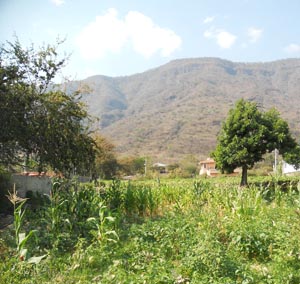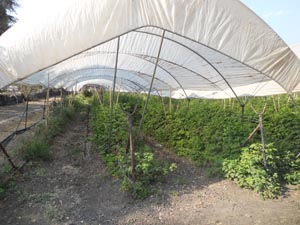Westwords

Corn was the crop of choice 17 years ago when we landed in Mexico, on the shores of Lake Chapala. Everybody who had a patch of ground had a corn patch. More land, more corn, some for tamales, some for farm animals, some for the market.
A surge in tequila sales created a shortage of agave. Farmers chopped down their corn stalks, hurriedly plowed their land and went after new money. Soon there were great tracts of agave.
Maturation takes time and in time, supply exceeded demand. Prices tumbled. You could see the impact. What had been clean rows of agave were invaded by weeds. Farmers gave up and got jobs in manufacturing, the better to maintain their red pickup trucks with fancy chrome in front.
Knee-jerk agriculture is again on an exciting rise in our part of Mexico. Berries are the “in” thing. In much of Jalisco and some of Michoacan, white Quonset huts by the thousands have popped up. The tunnel houses, simple rounded aluminum frames covered with sheet plastic, have strawberries, blueberries, raspberries and blackberries flourishing inside.
This greenhouse technique speeds and expands the growing season and shelters the fruit from birds, dust storms and aliens in spaceships. Results have been phenomenal. Quality and quantity are off the charts.
International companies have invested. Driscoll’s and Dole are strong in our neighborhood. A company from Chile has joined the competition. More and better jobs have been created.
Some berry farmers had extensive acreage in carrots, onions and cabbage. Some have combined family holdings into berry farms. Some have leased large additions. Sorting, packaging and shipping centers have sprung up. This is big.
The original target market was the United States. It already had the appetite and transportation was in place. The Mexico berry business went on to Europe. Sales are rising in Japan. Last month, a Chinese delegation inspected and approved Mexico methods of risk management, primarily refrigeration facilities and pest control.

An air freight company is operational out of Guadalajara. It is already flying to Hong Kong and Seoul. Could be the world has been waiting for a dependable year-round supplier of tasty fruit.
Middle Mexico has been strawberry country for centuries. Irapuato, a small town in Guanajuato, once thought of itself as the strawberry capital of the world. California, Florida and several places in Russia grow and sell more but Irapuato is still in the game. The town soccer team is called the Fresneros.
The Mexico berry business has doubled and redoubled in the past decade. Just follow the noise to measure the impact.
WalMart got into trouble with the Florida Strawberry Growers Association for selling Mexico berries in Plant City. More than 10,000 acres of strawberries are grown there each year.
A WalMart spokesperson said the company imports berries only when demand exceeds the local supply. Association director Ted Campbell says not so, it is all about cost and profits.
“This is an absolute insult to your local customers,” Campbell said to WalMart. “There is no greater disrespect to this community than bringing imported strawberries into the center of the primary domestic production area.”

We are tiny partners in this Mexico boom. We buy an occasional quart of rejects, more often strawberries or raspberries.
Blueberries travel well. Blackberries are easily handled. If strawberries or raspberries are harvested one day past their peak, they are classified as culls and are dumped into the local market at reduced prices.
Cost? Not much. We have purchased strawberries by the kilo for 10 pesos, 2.2 pounds for about 80 cents. We paid 12 pesos for raspberries out of a pickup truck at a farm gate.
We talked at length with a couple who are deep into the berry business, 10 years working for Driscoll’s, three years on their own. They asked that I not mention their names.
“We are now big enough to be scared of extortion or even kidnapping,” the man said.
They sell to Driscoll’s.
“The company furnishes everything except the land and labor.”
Pickers use buckets and do some sorting as they go. There is a rush to move filled clamshells into boxes onto pallets into coolers and into 18-wheelers ready for the road.
This husband and wife work as a team. He oversees the fields. She does the numbers. They have 35 employees. They add 75 pickers for March and April.
Worst problems? Mondays are bad for the workforce. There are predictable no-shows. Fighting bugs with back-sprayers is a tough task. Driscoll’s provides the formula for spraying.
Francisco Javier Vargas Olmedo is less troubled by the threat of crime. He says he farms 25 acres, eight in strawberries, 12 in conventional raspberries, five in organic raspberries.
Carmen Perez, four brothers and five sisters are immersed in the business. Carmen drives from her home in Guadalajara to tend 59 acres of raspberries, blueberries and strawberries.
Indeed, this is big.
If you discover a bright clamshell of fresh berries in your London or Tokyo specialty market, look closely at the label. If it says “Product of Mexico,” buy it.
Good stuff, packed with rich flavor and healthy nutrients. I’m almost confident enough to offer a money-back guarantee.
